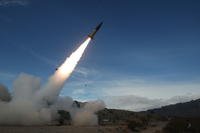A Pentagon source told us recently that the issue that literally keeps senior military people up at night is the prospect of an Israeli strike against Iran’s nuclear program.
In recent months, the rhetoric coming from high-level Israeli military and political officials in meetings with U.S. officials has become increasingly hawkish as Israel sees a narrowing window of opportunity to inflict enough damage to slow Iran’s progress in developing a nuclear weapon and at a small enough cost.
The Obama administration has been frantically cobbling together a package of incentives to try and convince the Israelis to keep their bombers out of Iranian air space. Placing a ring of anti-ballistic missiles at sea in the Persian Gulf and at sites on the Arabian Peninsula is a key part of that effort, the source tells us.
Because of Arab sensitivities, the U.S. cannot come out and say that anti-ballistic missiles placed on Arab territory are meant to protect Israel. But they will do just that.
Obama administration military officials do not see Russia as a threat. In public statements, Defense Secretary Robert Gates, who spent many years eyeballing the Soviet threat from his perch at the CIA, has repeatedly downplayed Russian military capabilities, almost to the point of outright mockery. He sees a more real and immediate threat, as he said at his press conference yesterday: “The intelligence community now assesses that the threat from Iran's short- and medium-range ballistic missiles, such as the Shahab-3, is developing more rapidly than previously projected.”
Strategy is all about making smart choices with limited resources. The immediate threat to U.S. interests is the regionally destabilizing fallout of an Israeli strike against Iran and all that would imply for the U.S. wars in two countries that abut Iran. Hence, the shift in missile defense from defend Europe to defend Israel and Arab Gulf allies. Much of the official language out of the White House and DoD will seek to mollify the offended parties in Eastern Europe. Michele Flournoy, the undersecretary of defense for policy, and Ellen Tauscher, the undersecretary of state for arms control, are in Europe talking to U.S. allies.
Behind the scenes, near term deployments will focus on boosting missile defense capabilities in the Gulf. The first phase of the missile defense aimed at deterring Israel will be based at sea, and has already started. As Gates said: “We will deploy Aegis ships equipped with SM-3 interceptors, which provide the flexibility to move interceptors from one region to another if needed.” He said that Aegis ships are already in the Gulf; an Aegis cruiser can carry around 100 SM-3 missiles.
There will also be a land-based component. As Gen. David Petraeus writes today in the The Times: “Iran constitutes the main state-based threat to stability in the region. The impact of its malign activities and harsh rhetoric are felt throughout the Arabian Peninsula, making it, ironically, the best recruiter with prospective partners. We now have eight Patriot missile batteries spread across countries on the western side of the Gulf, where two years ago we had far, far fewer.”
Patriot is a point defense system. Sources tell us that DoD is trying to get Terminal High Altitude Area Defense (THAAD) batteries to the United Arab Emirates, but Lockheed Martin can’t build them fast enough for the Army, let alone for overseas sales. THAAD is just completing its testing and is beginning initial fielding of two batteries with the Army. One of the Army’s powerful X-band radars is currently deployed in Israel's Negev desert. Under development is a capability to tie X-band radars to the Navy’s SM-3 interceptor missiles.
As Gen. Cartwright said yesterday, the land-based version of SM-3, that has been used in testing, is already a go. “We'll put together the system in a deployable configuration so that we can move it forward to places like Europe.” Note that he said “like” Europe. Also, while the first THAAD battery is scheduled to deploy to Europe, don’t be surprised if that battery is diverted to a U.S. base in the Gulf, such as in Qatar or even Israel.
The Jerusalem Post is reporting that the U.S. may leave missile defense systems in Israel following the “Juniper Cobra” joint missile drills scheduled for next month. It will be the largest joint exercise between the two countries and will include tests of the Israeli Arrow 2 system, THAAD and Aegis.
As we’ve written here before, the Pentagon, as will be evident in the forthcoming QDR review, is very much focused on “high end asymmetric threats”; specifically, how to counter the increasingly capable ballistic missile arsenals of countries such as Iran. Lost in the fevered criticism of the administration from more conservative circles is the importance of these steps in addressing real threats to U.S. security interests and those of its ally Israel.








